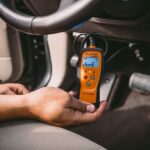Diagnosing air conditioning issues in your 2008 Land Rover LR2 might seem daunting, but with the right tools and knowledge, you can perform some initial checks yourself. One surprisingly simple method involves using your OBD2 scanner to read the AC pressure directly from the vehicle’s computer. This article will guide you through understanding your 2008 LR2 OBD2 specifications for accessing AC pressure readings, empowering you to troubleshoot your AC system like a seasoned technician.
Understanding OBD2 and AC Diagnostics in Your LR2
The On-Board Diagnostics II (OBD2) system is a standardized system in modern vehicles, including the 2008 Land Rover LR2, that allows you to access a wealth of data about your car’s performance and health. While many assume OBD2 scanners are only for engine diagnostics, they can also provide valuable insights into other systems, including the air conditioning.
In the LR2, the Engine Control Module (ECM), also known as the Powertrain Control Module (PCM), monitors the A/C Pressure Sensor Voltage. This sensor is located on the high side of your AC system and provides a voltage signal that corresponds to the refrigerant pressure. Crucially, the LR2, unlike some vehicles, does not have a dedicated low-side pressure sensor accessible via OBD2. However, understanding the high-side pressure is a significant step in diagnosing common AC problems.
It’s important to note that while the HVAC module does show the evaporator temperature, which can indirectly suggest low-side pressure conditions, direct pressure readings via OBD2 focus on the high side. This high-side reading is invaluable for determining if you have sufficient refrigerant and if the system is building pressure as expected.
Accessing and Interpreting AC Pressure Readings on a 2008 LR2 via OBD2
To check your 2008 LR2’s AC pressure, you’ll need an OBD2 scanner capable of reading live data. Most basic to mid-range scanners offer this functionality. Here’s how to proceed:
- Connect your OBD2 scanner: Plug your scanner into the OBD2 port located under the dashboard on the driver’s side of your LR2.
- Navigate to Live Data/PID Readings: Turn on your vehicle’s ignition (no need to start the engine unless your scanner requires it). Access the “Live Data,” “Parameter Identification Data (PID),” or similar section in your scanner’s menu.
- Locate “PCM – A/C Pressure Sensor Voltage”: You’ll be navigating through a list of sensors. Look for “PCM” (Powertrain Control Module) and then find the “A/C Pressure Sensor Voltage” PID. It might be listed under different names depending on your scanner, but keywords like “A/C Pressure,” “Pressure Sensor Voltage,” and “PCM” will guide you.
- Record the Voltage Reading: Select this PID to display the live voltage reading. Note this value down.
An OBD2 scanner connected to the diagnostic port of a vehicle, illustrating the first step in accessing AC pressure data on a 2008 LR2.
Converting Voltage to PSI: The Formula for Your LR2
The voltage reading from the sensor isn’t directly in PSI (pounds per square inch), the standard unit for pressure. You need to convert the voltage to PSI using a specific formula. While the exact formula for the 2008 LR2 might not be officially published by Land Rover for OBD2 readers, testing and online resources point to a reliable conversion:
*High Side PSI = (Voltage 93) – 16**
Let’s apply this formula to example readings similar to those observed in practical scenarios:
- Example 1: AC Off Reading: If your scanner reads 1.65v with the AC turned off, the calculated pressure is: (1.65 * 93) – 16 = ~137 PSI.
- Example 2: AC On Reading: If the voltage jumps to 1.85v when you turn the AC on, the pressure becomes: (1.85 * 93) – 16 = ~156 PSI.
These pressure ranges, 137 to 156 PSI, are within the expected range for R134a refrigerant at an ambient temperature of approximately 65°F (around 18°C). Standard R134a pressure charts can help you interpret these values based on your ambient temperature.
Troubleshooting AC Issues with OBD2 Pressure Readings
Reading your 2008 LR2’s AC pressure via OBD2 is a valuable first step in diagnosing AC problems. Here’s how to interpret the readings and what to do next:
- No Voltage Signal: If your scanner shows no voltage signal or a very low reading (close to zero) for the A/C Pressure Sensor Voltage PID, it could indicate a faulty sensor or a wiring issue. Check the sensor connections and consider sensor replacement.
- Very Low Pressure Readings (Below Expected Range): Consistently low pressure readings, even with the AC running, might point to a refrigerant leak or a system undercharge. You may need to check for leaks and potentially recharge the AC system.
- High Pressure Readings (Above Expected Range): Excessively high readings could indicate overcharging, a blockage in the system, or a faulty pressure sensor. Overcharging can damage your AC system and should be addressed promptly.
- Pressure Not Changing When AC is Turned On: If the voltage and calculated pressure remain static whether the AC is on or off, it might suggest a problem with the compressor or the AC system’s ability to build pressure.
Traditional AC manifold gauges, tools that provide direct pressure readings but require manual connection to the AC system, contrasting with the OBD2 method.
While OBD2 readings provide a good initial assessment, they are limited to the high-side pressure. For a comprehensive AC system diagnosis, especially concerning low-side pressure or system performance, professional AC manifold gauges are still recommended. However, for a quick check and initial troubleshooting, leveraging your OBD2 scanner to read your 2008 LR2’s AC pressure specifications offers a convenient and insightful starting point for any DIY enthusiast or car owner. If you are unsure or encounter persistent issues, consulting a certified automotive AC technician is always the best course of action.
